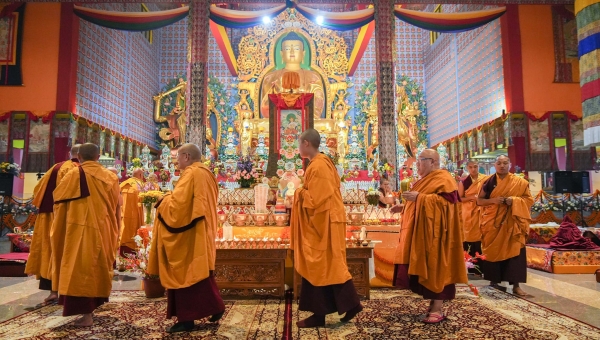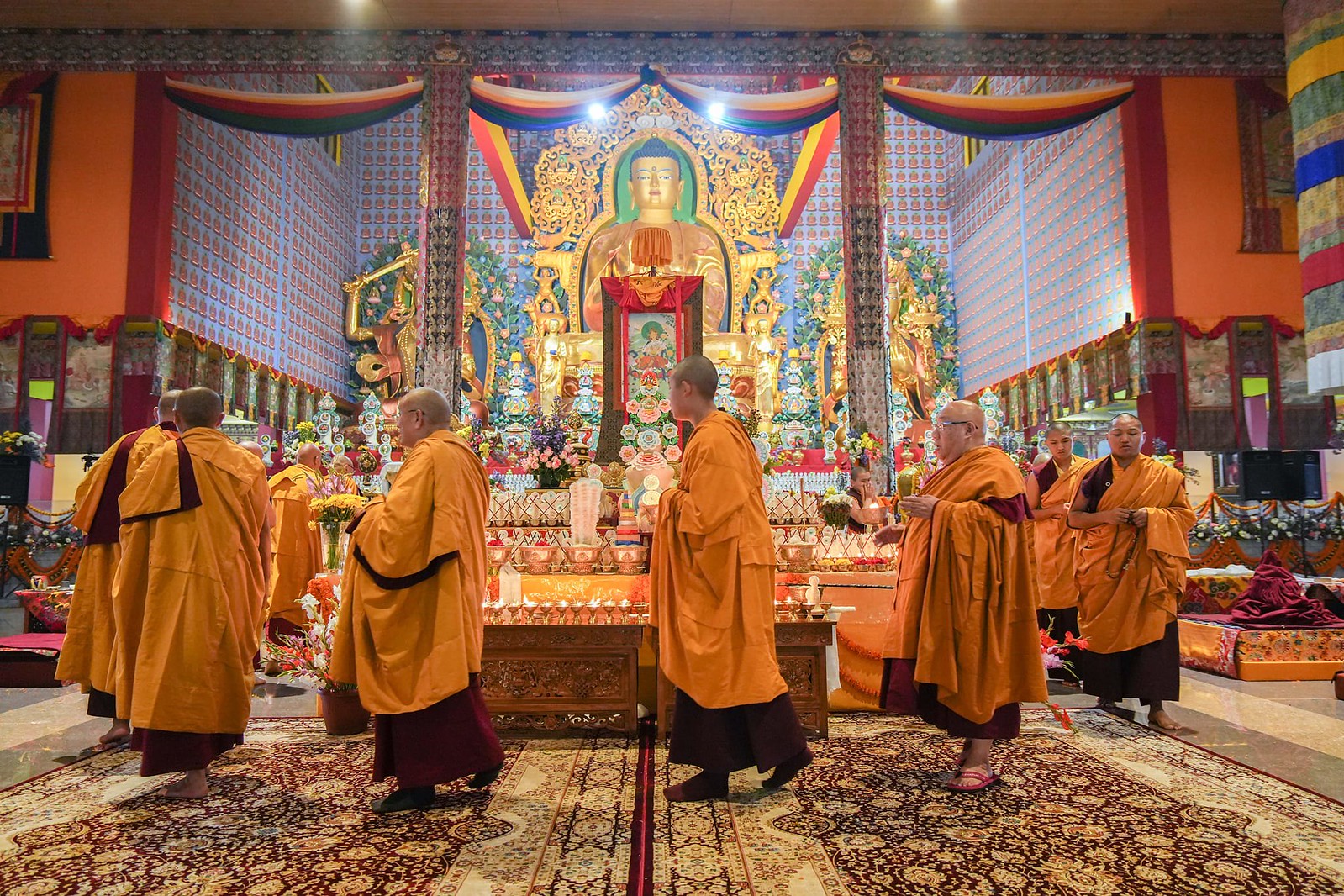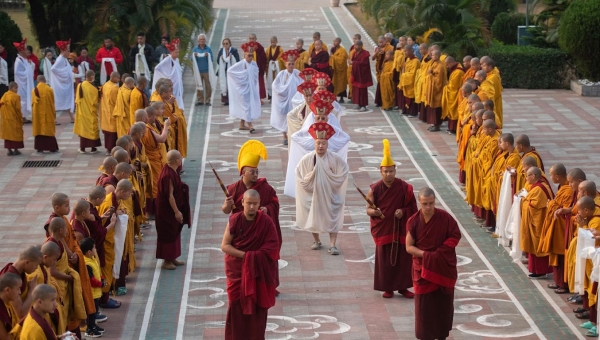Special Kagyu Monlam Day 8
5 February 2023
After an extensive mandala offering, headed by Bokar Rinpoche Yangsi and Khenpo Lodoe Dӧnyo Rinpoche, the Karmapa addressed all those who had attended the Monlam, plus monasteries, nunneries, dharma centres and students world-wide over a webcast ZOOM link.
The following is an edited transcript.
Now, normally during the Kagyu Monlam programme, I usually say a few words at this point. Actually, I should have spoken yesterday, but I was way too busy, so I even forgot that I was supposed to speak. It wasn’t until later, when I saw on the Internet that they were showing an event live, that I wondered what it was. I asked the organisers, “Why are you showing this event live?” and the reply was, “It's because we're waiting for you to give your talk.” Only then did I remember, and I thought, “It’s not going to work today, I'll do it tomorrow.” That's what I thought. I was so busy yesterday that I even forgot that I was supposed to speak.
This year at the Bokar Shedra, we first had the 23rd Kagyu Gunchoe, and then we had the Special Kagyu Monlam. So, we've had two large dharma activities happening one after the other. The people who primarily did all the preparations were the Bokar Shedra, and, needless to say, everyone has commended the really excellent preparations, and from everything I have seen, that's what I see too. Everyone says that the workers at Bokar Shedra and everyone involved worked very hard and did everything very well. Many people have told me this.
So, at this point, I'd like to take the opportunity to thank Bokar Rinpoche and Khen Rinpoche, as well as the Bokar Shedra and the main monastery, all of the workers, the administrators, and all of the lay and monastic people. I'd like to express my thanks and gratitude.
Now, in terms of the Kagyu Gunchoe, for the last few years, all of the expenses have been covered by Tsurphu Labrang, and the preparations have been done in rotation by the various shedras. This year was the turn of Bokar Shedra, which is why we held the Gunchoe at Bokar Shedra and Bokar Shedra took responsibility for organising it. This system has made it much easier to handle.
At the same time, since we normally have the Monlam right after the Kagyu Gunchoe and the sangha was already at Bokar Shedra, it seemed sensible to continue and hold the Monlam there as well, and everyone was in agreement. Regarding the sponsorship of the Monlam, Bokar Rinpoche and Khen Rinpoche said that they would sponsor it and they have taken great care and have been very generous in their sponsorship. When I read the list of offerings during the Special Monlam, I noted that all of the expenses were paid by Bokar Labrang, their office of administration, so I would like to thank them very much for sponsoring this.
The Bokar Changzӧ (General Secretary) is actually ill at the moment and was unable to attend because of his illness. He's currently in Taiwan. He has a very pure motivation and is someone who can really provide good service and support to Bokar Rinpoche and Khen Rinpoche. So, I'd like to ask everyone in the sangha to make vast aspirations that he may be swiftly cured and returned to good health.
Today, as you all know, we had the practice of the Five-Deity Green Tara of the Acacia Forest. Wherever he went, the previous Bokar Rinpoche always carried a Tara statue with him. Everywhere he went, he had the statue with him. Tara was his special yidam deity. When I visited him at his monastery, it seemed as if there was a Tara statue in every shrine room. There were peaceful, enriching and magnetising forms of Tara—but I don't think there were any wrathful ones.
Khen Rinpoche also has Tara as his special deity, his main source of hope and inspiration. During the Kagyu Gunchoe we had the ritual of the Five-Deity Hayagriva, and when I was discussing this with him beforehand, Khen Rinpoche suggested that it would be good to do the Five-Deity Tara practice as well. And so that is what we have done. We decided then that it would be good to have the Five-Deity Hayagriva during the Gunchoe, and today we were able to do a very elaborate and lengthy Tara practice with the Five-Deity Tara ritual text. It’s not complete yet, but through the practice today, we have made a very good connection, and that’s a good sign.
These are the main things.
Because of these roots of virtue, may all the saints and masters of all the different sects and lineages live long, and may their activity flourish. May the members of the sangha all live in harmony. And then, in the world, in all this vast world, may there be no more illness, famine, war, and so forth. These are the reasons why we hold the Monlam.
The situation these days is that Bokar Yangsi Rinpoche is quite young and Khenpo Lodoe Dӧnyo Rinpoche has reached the age of 80. During his 80th birthday celebrations, I had the opportunity to speak to him, so I told him that he should make the determination to remain in this world and live for another ten or twenty years, so that he can support the Buddhadharma and, in particular, the teachings of the Kagyu, in order to preserve the foundations laid by the previous Bokar Rinpoche.
The previous Bokar Rinpoche and Khen Rinpoche had a very deep connection. Wherever they went, they were always together. This was a really good example for everyone to see. The Dalai Lama praised them highly. Everyone in all the different monasteries said that Bokar Rinpoche and Khenpo Lodoe were inseparable and always such good upholders of the Vinaya. This is praised highly. Many Geshes whom I know have also told me about this: everyone respected them very highly.
Because Khenpo Rinpoche had such a strong connection with the previous Bokar Rinpoche, if he can continue to remain in this world, he will be able to teach Bokar Rinpoche, give him advice and guide him. Rinpoche needs someone like that. I, myself, when I was young, didn't have anyone like that. There were people who told me what to do and gave me orders but no one who really treated me well or gave me guidance. I didn't really have anyone like that. I think while Rinpoche is still young, to have someone who shows affection and takes such care of him, as opposed to having someone saying, “You have to do this” and “Don't do that”, is really important. Rather than having someone who acts like a god, someone who is just giving you orders, to actually have someone who really has love and affection for you from the depths of their heart is really important. There's no one who's better at that than Khenpo Rinpoche, so it would be really beneficial if Rinpoche could live for at least another ten years. If he lived for as long as possible, he should live for thousands of years! But, as I said the other day, I make the aspiration that he can live for a further ten or twenty years, and I request him to also make such aspirations, please make such prayers, and everyone in the sangha, please make such prayers.
This year we have been able to hold an actual Kagyu Winter Teaching, an actual Kagyu Monlam, and there will be an actual Spring Teaching for the nuns. Because many people gather from abroad for the Kagyu Monlam, I suggested that it was better to postpone holding the Kagyu Monlam Chenmo in Bodhgaya for another year. I think, however, that next year we will definitely be able to hold the Monlam in Bodhgaya.
For myself personally, what should I say? I haven't been able to come to India for several years, five or six years, and so I would like to return. It is my hope to return to India, and I think that there are quite a few people both inside and outside India who are wishing for this. I do have the wish to return. There is no need to mention the reasons I want to come back—you all know.
However, as you all know, during those 18 years I was in India, although I had a few chances to go abroad, I spent most of that time in India. Not just that, but different things happened, difficult situations, and many problems. That experience and the imprints of that experience are still there, so it's not so easy for me to come back immediately. If I came back and the situation was the same, if I were to experience all the difficulties like before and not have much freedom, if that were the case, there wouldn't be any point in coming back. If I had to return to the situation as it was before, and spend another decade or so in that situation, there would be no point. I'm in my thirties now, so if I had to spend another twenty or thirty years under those conditions, I’d be an old man, and it would be pointless. For these reasons, this is something that needs to be thought through carefully.
As I've said before, the Noble Land of India and Tibet have had various connections in terms of the Dharma and samaya for thousands of years. In particular, fifty or sixty years have passed since the time that His Holiness the Fourteenth Dalai Lama came to India, and during that time, there has been a really deep connection between Tibetans and Indians. If we think in terms of the Kagyu tradition, we have established many monasteries. We have a lot of monks, lamas and nuns, and many great beings who have come, so it goes without saying, that this connection, this relationship is extremely important, and I consider it very priceless and valuable
This is basically what our attitude should be, but in terms of what we need to do and how to do it, we have to employ skilful means, Without the right methods, just having pure motivation is not sufficient. I have been carefully considering this, so, please, I'd like to ask you to bear this in mind. I think it’s important for everyone to understand.
In any case, when our karma and our aspirations come together, and I can return to India, we will be able to meet each other again. I'm looking forward to that. In the past, I was not able to visit Nepal or Bhutan, but in the future I hope to be able to come not just to India but also to Nepal and Bhutan.
I'd like to be able to see you all in person, and hope that we will be able to gather together in one place, so please put your minds at rest and don't worry about this.
Now, I really don't have anything else to say today. As I said before, we are working on getting me to India. We are holding discussions with the Indian government, and trying to do what we can, but it's not something that I could just do on the spur of the moment. It's something I have to think about, since I had so many difficulties previously. If they were still there, it would be very difficult. It’s not something I want to think about, but I have no choice but to consider them.
This affects not only coming to India but also Nepal. I did spend a few hours crossing through Nepal on the way to India, but I’ve not been able to visit Nepal since. I have great hopes that I will be able to visit Nepal in the future. Likewise with Bhutan. During the time of the previous Choegyals (Dharma Kings), the Karmapas had a close connection with them. I think there was even a connection dating back to the time of the Eighth Karmapa Mikyo Dorje; there’s a history of his visit to Paro Taktsang, [Tiger’s Nest Monastery]. So, I really hope to be able to visit Bhutan.
The Karmapa concluded by asking everyone to keep in mind what he had said, and then, in the absence of a Chinese translator, he gave a summary in Chinese.
Click on the photo to view Flickr picture gallery ↓


































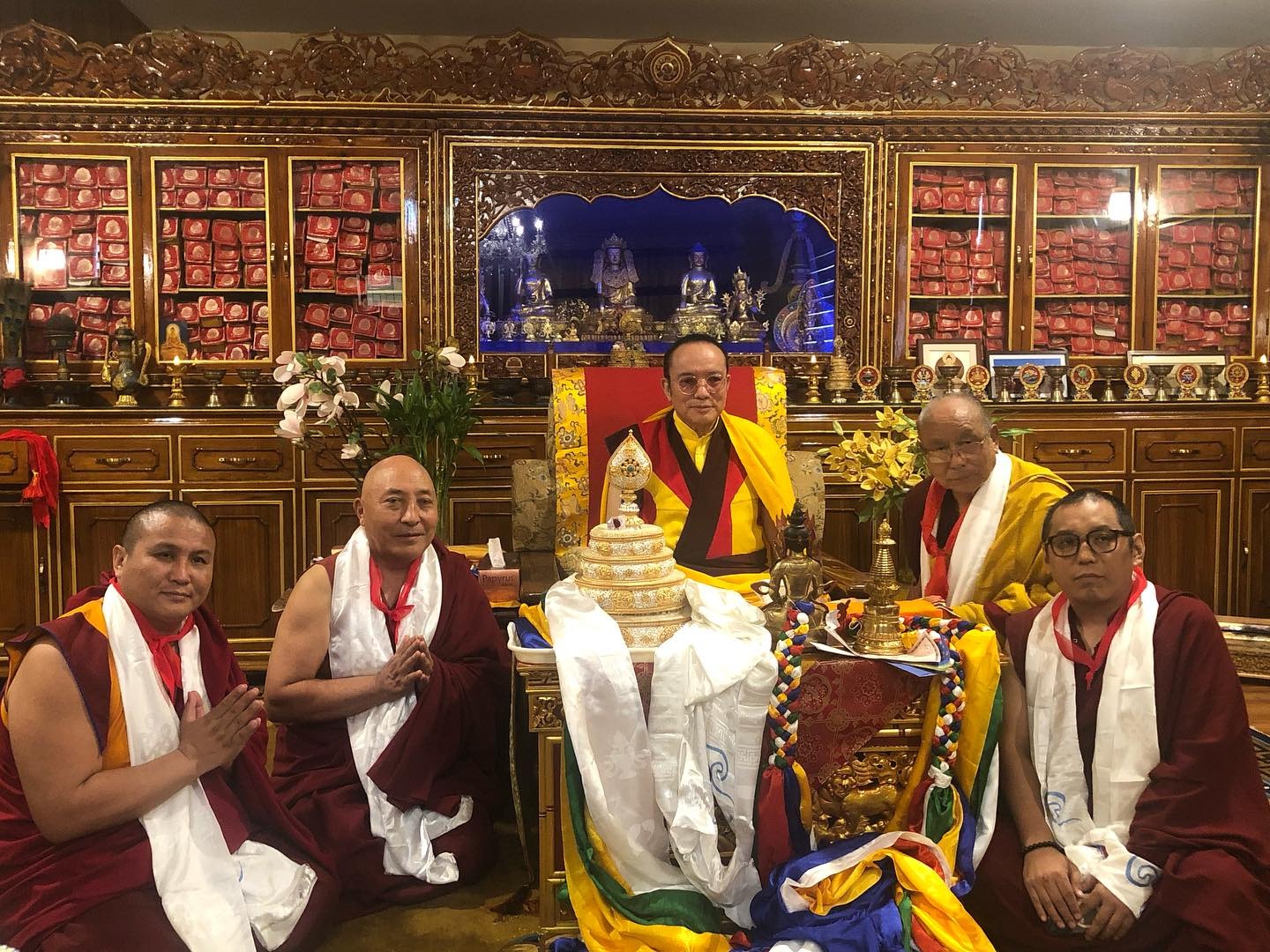
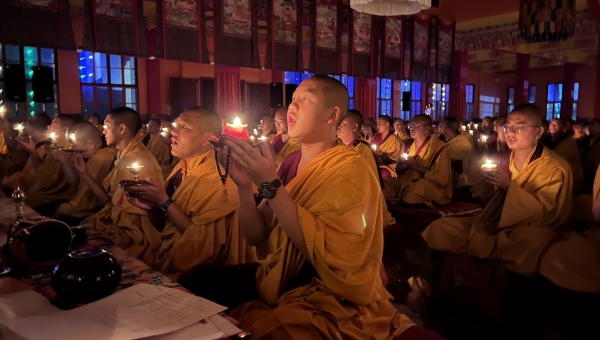
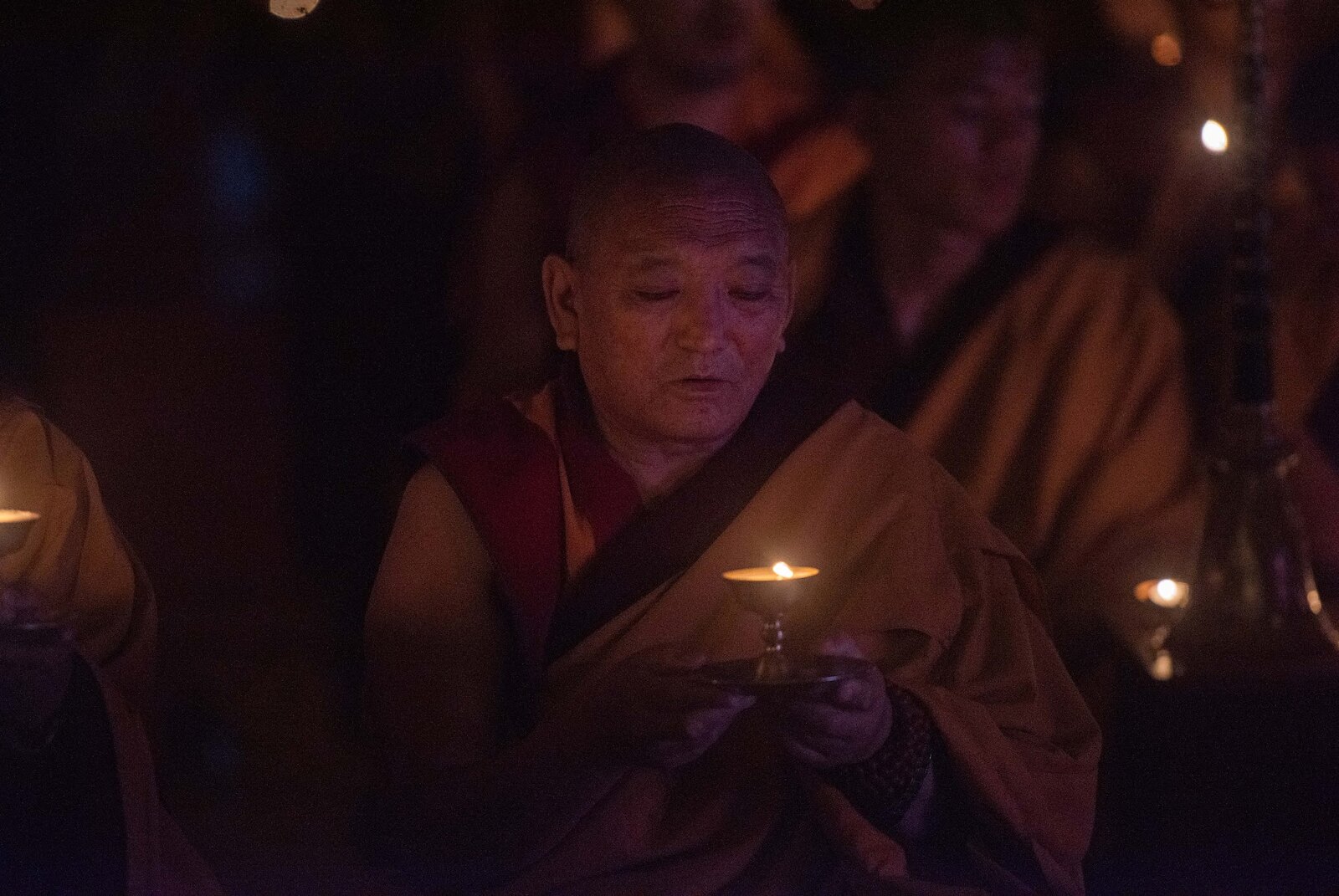
_thumbnail.png)

